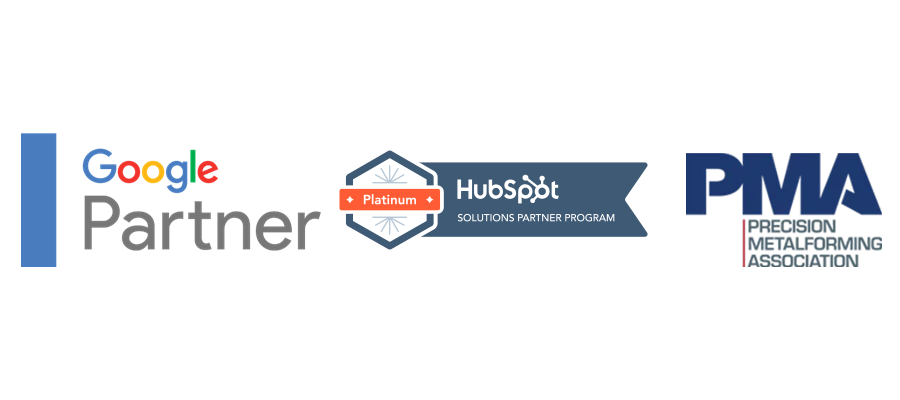How to Incorporate Industrial SEO Into Your Web Design
One of the most common mistakes that industrial websites are still making today is neglecting their website. While trade shows and mailer campaigns can still be effective marketing efforts, having a strong online presence is crucial for any industrial company- now more than ever. With the massive popularity of search engines and online research as B2B buyers’ tools, it’s important for industrial companies to have a well-designed website that is optimized for search engines.
There’s a name for that, one that MFG Tribe knows well: industrial SEO. In today’s blog post, we will discuss how to incorporate industrial SEO into your web design to improve your company’s online visibility and attract potential customers.
Understanding SEO for Industrial Companies
Industrial SEO, also known as manufacturing SEO, is the process of optimizing your website and online content to rank higher in search engine results pages (SERPs) for keywords related to your industry. By incorporating on-page industrial SEO into your web design, you can make your website more appealing to search engines, thereby increasing your chances of attracting potential customers.
Industrial SEO is more than just about optimizing your website for search engines. It’s also about understanding the needs and behaviors of your target audience and creating a website that shows potential customers just how your industrial business caters to these needs. This involves creating high-quality content that is relevant to your industry, optimizing your website’s structure and design for user experience, and using various SEO techniques to improve your website’s visibility in search engine results.
Why is Industrial SEO Important?
With the increasing competition in the industrial sector, having a strong online presence is crucial for companies to stand out and attract potential customers. Think about it yourself: how likely are you to spend time on a website with long loading times, a confusing menu to navigate, or little to no information about what a company does?
According to a 2020 study by ThomasNet, 73% of buyers in the industrial sector consider a supplier’s website when making purchasing decisions; and many of these buyers use search engines as their #1 tool to research potential suppliers. This highlights the importance of having a well-optimized website that can easily be found by potential customers.
While attracting potential customers is important, industrial SEO doesn’t just stop there. Facets of SEO like high-quality content play a huge role in building your brand’s credibility and trust with your target audience. A well-optimized website can help you establish your company as a leader in your industry, thereby increasing your chances of not just attracting potential buyers, but also retaining customers.
Incorporating SEO into Your Industrial Web Design
Now that we’ve covered the importance of industrial SEO, let’s discuss how to incorporate it into your web design. Incorporating industrial SEO into your web design is a multi-step process which includes keyword research, website structure optimization, mobile-friendly design, image optimization, local SEO, and content creation.
1. Keyword Research
The first step in incorporating industrial SEO into your web desi gn is to conduct keyword research. The results of your keyword research will act as your guide to show where to direct your industrial SEO optimization efforts.
gn is to conduct keyword research. The results of your keyword research will act as your guide to show where to direct your industrial SEO optimization efforts.
The research stage involves identifying the keywords and phrases that potential customers are using to search for products or services in your industry. There are many online tools available to help with your keyword research, such as Google Keyword Planner (free to use with a Google Ads account!) and SEMrush.
Once you have identified the keywords that are relevant to your company’s industry, make sure to incorporate them into your website’s content. This includes updating page titles, meta descriptions, and headings; however, it’s important to use keywords naturally and avoid keyword stuffing, as this can negatively impact your website’s ranking. Additionally, it’s also important to keep track of the performance of your keywords and adjust your strategy accordingly. This can help you stay ahead of the competition and ensure that your website remains relevant to your target audience despite changes in trends.
2. Optimize Your Website’s Structure
Having a  well-structured website is not only important for user experience but also for SEO. To document what’s on your website and determine where to place it in SERPs, search engines use bots commonly referred to as crawlers. These crawlers use website structure to understand the content and hierarchy of your website. Here are some tips for optimizing your website’s structure for industrial SEO:
well-structured website is not only important for user experience but also for SEO. To document what’s on your website and determine where to place it in SERPs, search engines use bots commonly referred to as crawlers. These crawlers use website structure to understand the content and hierarchy of your website. Here are some tips for optimizing your website’s structure for industrial SEO:
- Use descriptive and keyword-rich URLs for your web pages.
- Avoid URLs with convoluted strings of letters and numbers that aren’t relevant to the page’s content. If you can’t understand what a page is about based on its URL, it needs to be updated to be clear and concise.
- Use header tags (H1, H2, H3) to organize your on-page content and include relevant keywords in them.
- Create a sitemap to help search engines crawl and index your website more efficiently.
- Ensure that all of your web pages can be accessed through the sitemap.
By making your website easier for crawlers to navigate, it should also become easier for potential customers to navigate as well. A well-structured website can help users find the information they are looking for quickly and easily, thereby improving user experience and increasing the chances of conversion.
3. Mobile-Friendly Design
 With the majority of internet users accessing websites through their mobile devices, having a mobile-friendly website is crucial for industrial SEO. In fact, Google now uses mobile-first indexing, which means that it primarily uses the mobile version of a website for indexing and ranking. With this in mind, it is essential for industrial companies to have a responsive web design that provides a seamless user experience across all devices.
With the majority of internet users accessing websites through their mobile devices, having a mobile-friendly website is crucial for industrial SEO. In fact, Google now uses mobile-first indexing, which means that it primarily uses the mobile version of a website for indexing and ranking. With this in mind, it is essential for industrial companies to have a responsive web design that provides a seamless user experience across all devices.
In addition to improving your website’s SEO, a website that is easy to navigate and view on mobile devices can help you attract and retain more customers. A mobile-friendly design can also give your business a competitive edge, as many industrial companies have yet to fully optimize their websites for mobile devices.
4. Optimize Your Images
Images play a crucial role in improving the industrial user experience, but they can also positively impact your website’s SEO. Here are a few tips for optimizing images for industrial SEO:
- Use descriptive file names for your images that include relevant keywords. Like URLs, clear image descriptions can help crawlers properly index the information on your website and boost your page’s SERP ranking.
- Compress your images to improve website loading speed. Who likes a slow website?
- Use alt tags to describe your images, as search engine crawlers cannot read images themselves but can read file names and alt tags.
In addition to these tips, it’s also important to choose images that are relevant to your content and industry. The right images can help you engage your audience, improve user experience, and help you establish your company as a professional and credible business.
5. Incorporate Local SEO
For industrial companies that have a physical location, incorporating local SEO into your web design is crucial. This involves optimizing your website for local search queries, such as “industrial companies near me” or “manufacturing services in <insert your city>.” Here are some tips for incorporating local SEO into your web design:
- Include your business’s name, address, and phone number (NAP) on your website. These should be easy to find, but out of the way- NAPs usually reside at the top or bottom of each web page.
- Create a Google My Business listing and optimize it with relevant keywords and business information. Don’t forget to include a link to your website!
- Get listed on online directories and review sites, such as Yelp and Yellow Pages.
It’s important to encourage your customers to leave reviews on your Google My Business listing and other online directories. Positive reviews can help you build credibility and trust with your target audience and also improve your website’s visibility in local SERPs.
6. Create High-Quality Content
Once your web design is optimized for industrial SEO, it is important to put out a steady stream of high-quality digital content that is relevant to your business offerings and your audience’s interests. This includes creating informative content that incorporates your target keywords and publishing it at the right time based on industry trends. Here are some tips for creating high-quality content for industrial SEO:
- Conduct ongoing research on industry-related topics and keywords to create informative and valuable content for your target audience. Their preferences will change with time, so it’s important to do this regularly.
- Use a mix of different types of content, such as blog posts, videos, infographics, and case studies, to keep your website engaging and diverse. We find that videos consistently perform the best with industrial audiences, but it’s important to produce a mix of content for different audiences,
- Regularly update your website with fresh and relevant content to improve your website’s ranking and drive audience engagement.
Incorporating industrial SEO into your web design is crucial for industrial companies to improve their online visibility and attract potential customers. By conducting keyword research, optimizing your website’s structure, and creating high-quality content, you can improve your website’s ranking and attract more traffic. Additionally, incorporating local SEO and ensuring a mobile-friendly design can further enhance your website’s SEO. By following these tips, you can effectively incorporate industrial SEO into your web design and stay ahead of the competition in the industrial sector.
Moreover, it’s important to remember that SEO is not a one-time task. It requires continuous effort, monitoring, and adaptability to ensure that your website remains relevant and visible to your target audience. By regularly updating your website and adjusting your SEO strategy based on the latest trends and changes in search engine algorithms, you can ensure that your website stays ahead of the competition and continues to attract potential customers.
If you found today’s blog post helpful, be sure to give it a share on your platform of choice. Thanks for reading. We’ll see you on the next one!
Solidify Your Industrial Success!
Contact Us Today for Tailored Marketing Solutions




